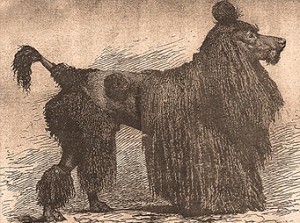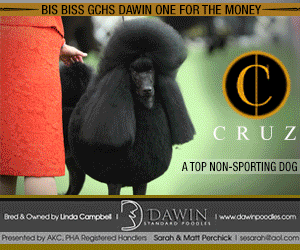Tattletales – The Tail Tells All!
228 – October, 2018
BY: WENDELL SAMMET
Edited by Lisa Dubé Forman
reprinted from page 90 – August 2016
 REGULARLY OVERLOOKED AND MISUNDERSTOOD, A DOG’S TAIL, IN FACT, HAS A CONSIDERABLE IMPACT ON MANY OF OUR BREEDS, AND COMMUNICATES A GREAT DEAL, BUT IS ANYONE LISTENING?
REGULARLY OVERLOOKED AND MISUNDERSTOOD, A DOG’S TAIL, IN FACT, HAS A CONSIDERABLE IMPACT ON MANY OF OUR BREEDS, AND COMMUNICATES A GREAT DEAL, BUT IS ANYONE LISTENING?
Mainly, as an appendage, the tail aids in the maintenance and recovery of equilibrium, it supports locomotion and also helps round off physical balance. Moreover, concerning dog body language, besides posture, the tail is a communication device ensuing in the maxim, “A dog thinks with his tail.” Under any circumstances, it is a temperament and/or mood barometer with carriage and action indicating mental attitude. A wagging tail usually is a sign of happiness and confidence with the limp, tucked tail denoting an uncertain, shy and possibly fearful dog.
All dog breeds have tails. These can be long, short, docked and undocked, and when left natural they may have twists, curves, and curls. The anatomy of tails is elementary for most knowl- edgeable dog breeders. Nevertheless, here is a hasty but adequate introduction, like a “Tail Fundamentals: 101,” that will be very useful for new exhibitors and fanciers.
The tail is the final portion of the spine and is composed of approximately 20 small, triangular-shaped bones called vertebrae. What connects these multiple tail vertebrae to the back- bone is the sacrum of the pelvic girdle. The sacrum is precisely three fused or united vertebrae nestled between the two hip-bones. For this reason, the first four to five vertebrae of the tail cannot be seen as they are hidden in the girdle. However, we know that these vertebraes beginning shape are broad and long, and as the series of small bones continue forming the tail, they eventually reduce in size and decrease in width until the middle of the tail. Depending on the breed of dog, this location usually is around the 8th to 10th vertebrae. After this mid-point, the tail vertebrae become longer, thinner and smaller right to the tip of the tail. Excellent, now we know what a tail is made up of but how does it move?
The answer is simple. The tail’s vertebrae are mostly enclosed in tendons and muscles reaching to the last vertebrae bone. These various muscles run both topside and underneath the tail, and along with pelvic muscles, cause motion activated by the peripheral nervous system’s (PNS) spinal nerves. The nerves signal the muscles that are responsible for the flexor (tightening, bending and lateral movements) and levator (raising, extending) motions of the tail. These are the basic principles of what con- stitutes a dog’s tail. Still, how this relates to the Poodle breed is indeed more important because a Poodle tail set and how he carries his tail is paramount to the breed standard.
Click here to read the complete article228 – October, 2018
Short URL: https://caninechronicle.com/?p=152602
Comments are closed











